
The Crassulaceae, also known as the stonecrop family or the orpine family, are a diverse family of dicotyledon flowering plants characterized by succulent leaves and a unique form of photosynthesis, known as Crassulacean acid metabolism (CAM). Flowers generally have five floral parts. Crassulaceae are usually herbaceous but there are some subshrubs, and relatively few treelike or aquatic plants. Crassulaceae are a medium size monophyletic family in the core eudicots, among the order Saxifragales, whose diversity has made infrafamilial classification very difficult. The family includes approximately 1,400 species and 34–35 genera, depending on the circumscription of the genus Sedum, and distributed over three subfamilies. Members of the Crassulaceae are found worldwide, but mostly in the Northern Hemisphere and southern Africa, typically in dry and/or cold areas where water may be scarce, although a few are aquatic.
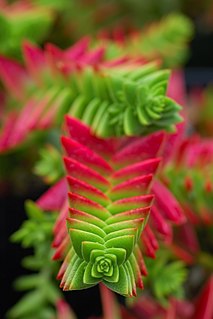
Crassula is a genus of succulent plants containing about 200 accepted species, including the popular jade plant. They are members of the stonecrop family (Crassulaceae) and are native to many parts of the globe, but cultivated varieties originate almost exclusively from species from the Eastern Cape of South Africa.

Crassula helmsii, known as swamp stonecrop or New Zealand pigmyweed, is an aquatic or semiterrestrial species of succulent plant in the family Crassulaceae. Originally found in Australia and New Zealand, it has been introduced around the world. In the United Kingdom, this plant is one of five introduced invasive aquatic plants that were banned from sale from April 2014, the first ban of its kind in the country. It is on the Global Register of Introduced and Invasive Species of eleven countries.

Crassula aquatica is a succulent plant known by the common names water pygmyweed, common pygmyweed and just pigmyweed. It is an annual plant of salt marshes, vernal pools, wetlands, and other fresh to brackish water bodies. It is at least partially aquatic, living in areas which are submersed much of the time. It also lives along muddy banks and in tidally-active areas of estuaries.
Crassula colorata, the dense pigmyweed or dense stonecrop, is an annual plant in the family Crassulaceae. The species is endemic to Australia, occurring in Western Australia, South Australia, New South Wales and Victoria.
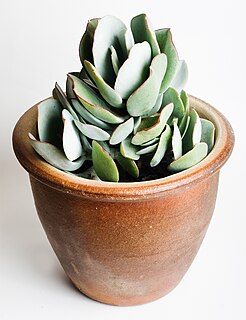
Crassula arborescens, the silver jade plant, silver dollar plant, beestebul, Chinese jade, money plant, or money tree, is a species of succulent plant in the family Crassulaceae. It is an endemic plant of the Western Cape, South Africa. It is a 2 to 4 ft succulent shrub. It has round gray "Silver Dollar" leaves. It blooms in winter, with white to pink flowers. It is cultivated as an ornamental plant for use in drought tolerant and succulent gardens, and in container gardens. It is also suitable for growing indoors as a houseplant.
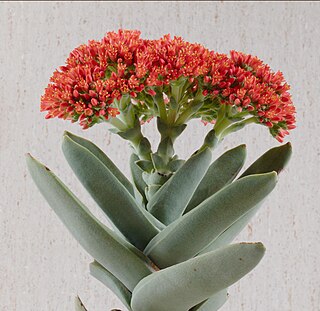
Crassula falcata, known by the common names airplane plant and propeller plant, is a succulent plant endemic to South Africa, from the Cape of Good Hope. The foliage is gray-green with striking texture, on plants that grow to 2 feet (0.61 m) tall. The flowers are tiny and scarlet red, that rise in dense clusters above the foliage for a month in summer. Crassula falcata is cultivated for use in drought tolerant and succulent gardens, and in container gardens.

Crassula elegans, the elegant crassula, is a flowering plant species in the genus Crassula.

Crassula muscosa, synonyms Crassula lycopodioides and Crassula pseudolycopodioides, is a succulent plant native to South Africa and Namibia, belonging to the family of Crassulaceae and to the genus Crassula. It is a houseplant grown worldwide and commonly known as rattail crassula, watch chain, lizard's tail, zipper plant and princess pines.

Crassula marnierana, common name Jade Necklace or Chinese Pagoda, is a species of succulent flowering plant in the family Crassulaceae.

Crassula capitella, is a perennial succulent plant native to southern Africa.

Crassula ovata, commonly known as jade plant, lucky plant, money plant or money tree, is a succulent plant with small pink or white flowers that is native to the KwaZulu-Natal and Eastern Cape provinces of South Africa, and Mozambique; it is common as a houseplant worldwide. Much of its popularity stems from the low levels of care needed; the jade plant requires little water and can survive in most indoor conditions. It is sometimes referred to as the money tree; however, Pachira aquatica also has this nickname.

Crassula deceptor is a succulent plant native to South Africa and Namibia. This species occurs from southern Namibia, to as far south as the town of Vanrhynsdorp in South Africa.
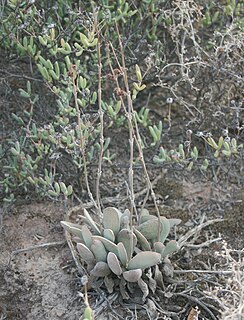
Crassula cotyledonis is a succulent plant endemic to the arid Namaqualand and Karoo regions of South Africa.

Crassula sarcocaulis is a small shrubby succulent plant known by the common name bonsai crassula, due to its bonsai-like appearance. It is a perennial plant native to the eastern half of South Africa, on mountain slopes in rocky terrain.
Asperula crassula is a species of flowering plant in the family Rubiaceae, endemic to a few hundred hectares in northeast Crete. It was first described in 1857.
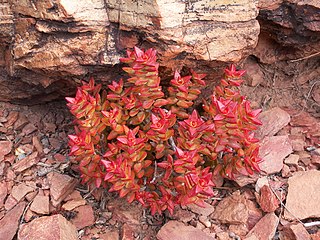
Crassula rupestris, called buttons on a string, is a species of Crassula native to the Cape Provinces of South Africa. It has gained the Royal Horticultural Society's Award of Garden Merit. It is also called bead vine, necklace vine, and rosary vine.

Crassula vaillantii is a species of herb in the family Crassulaceae. They are succulents plants.

Crassula umbella is a succulent plant species in the genus Crassula. It is endemic to the Cape Provinces of South Africa.

















